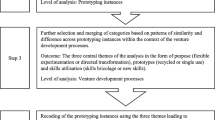Abstract
In the opening years of the new millennium, we are witnessing the creation of a “cult of innovation”. The word is on everyone's lips, and nowhere more so than in board rooms and executive offices of the world's great business enterprises. Innovation is something that every business values and wishes to create; yet it is a concept that often defies definition. It is not uncommon for a group of knowledgeable individuals to disagree not only about the value of innovation, but also about the meaning of innovation. One person's “innovation” can be another's “product or process improvement” (e.g., Gillette's new M3 PowerTM vibrating blade razor—innovation or product improvement?) and the ensuing dialogue frequently raises questions not only about the nature and definition of innovation, but also about the way in which innovation is used to create something useful and market-friendly. The perceived value of new concepts and inventions quite often colors whether they are seen as innovations, or whether they are seen as intellectual and/or laboratory curiosities. Moreover, concepts and inventions that might be deemed to be “innovative” (i.e., having value) at “Point Y” in history may not have been seen that way at “Point X” 20 years earlier. Innovations, consequently, are often declared retrospectively—many years may pass between the initial cognitive output and the recognition that it either represented, or was transformed into, an innovation. There are periods of time, however, when the process of “innovative thinking” is much more important than the actual creation of true innovations, and we are in such a period. It is this broad concept—the recognition, transformation, and profitable use of innovative thinking—which is discussed in this article.
Similar content being viewed by others
References
Schumpeter, J., Theory of Economic Development, Harvard University Press, 1934.
Schumpeter, J., Capitalism, Socialism and Democracy, Harper & Brothers, 1942.
Owen, D., “Making Copies,” Smithsonian, 35 (5), p. 96 (2004).
Matko, S.P., Private correspondence, 23 August, 2004.
Wismer, M., “Learning to Leap: Rising to the Technical Challenge of Today's Coatings Industry,” Journal of Coatings Technology, 62, No. 780, 86 (1990).
3M News Release, Campbell, P., Chief Financial Officer, 5 November, 2003.
O'Lenick, A.J., Jr., “Managing Intellectual Property or Getting More than a Penny for Your Thoughts,” The Chemist, March/April, p. 17 (2001).
Brundtland, G.H. (Ed.), Our Common Future: The World Commission on Environment and Development, Oxford University Press, 1987.
van Benthem, R.A.T.M., Private correspondence, 9 June, 2004.
van Benthem, R.A.T.M., “Coatings Technologie—Laat de Toekomst Uit de Verf Komen,” Technische Universiteit Eindhoven, 12 March, 2004, p. 5 (ISBN: 90-386-1233-8; www.tue.nl/bib.)
Wismer, M., Op. cit.“, pp. 83–88.
“Less Glamour, More Profit,” The Economist, 371 (8372) p. 11 (2004).
Ibid.“Less Glamour, More Profit”, The Economist, 371 (8372) p 11 (2004).
Cocuzzi, D.A. and Pilcher, G.R., “Cool Roofing: A Really Hot Topic”, JCT CoatingsTech, 1, No. 4, 22–29 (2004).
Dickie, R.A., “Chemical Origins of Paint Performance”, Journal of Coatings Technology, 66, No. 834, 29–37 (1994).
Brady, R.F., Jr., “Clean Hulls Without Poisons: Devising and Testing Nontoxic Marine Coatings,” Journal of Coatings Technology, 72, No. 900, 45–56 (2000).
Gardon, J.L., “Polyurethane Polyols: Ester-Bond Free Resins for High Solids Coatings,” Journal of Coatings Technology, 65, No. 819, 25–33 (1993).
Tucker, R.B., Driving Growth Through Innovation, Berrett-Koehler Publishers, Inc. 2002.
Christensen, C.M. and Raynor, M.E., The Innovator's Solution, Harvard Business School Press, 2003.
www.u-sit.net.
Schultz, W., “Nanotechnology: The Next Big Thing,” Chem. Eng. News, 78 (18), 41–47 (2000).
Ainsworth, S.J., “Nanotech IP,” Chem. Eng. News, 82 (15), pp. 17–22 (2004).
Jones, F.N., “Toward Solventless Liquid Coatings”, Journal of Coatings Technology, 68, No. 852, 25–36 (1996).
Pilcher, G.R., “Meeting the Challenge of Radical Change: Coatings R&D as We Enter the 21st Century,” Journal of Coatings Technology, 73, No. 921, 135–143, (2001). Also in Adler, H.-J.P. and Patje-Kamloth, K. (Eds.), Quo Vadis Coatings, Wiley VCH Verlag Gm bH + Co. KgaA, pp. 1–5, 2002.
Rassing J., “Coatings Developments for the New Millennium”, ECCA Conference Transcript, 22–23 November, 1999.
Topping, D., “Antimicrobial Surfaces for Appliances,” Appliance Engineer, p. 23 (May 2004).
Limbacher, K., “Pigment Dispersion”, Paint & Coatings Industry, pp. 82–85 (July 2004).
Bauer, D.R. and Martin, J.W. (Eds.), Service Life Prediction of Organic Coatings: A Systems Approach, American Chemical Society Symposium Series 722, Oxford Press, 1999.
Martin, J.W. and Bauer, D.R. (Eds.), Service Life Prediction Methodology and Metrologies, Oxford Press, New York, 2001.
Brockaert M., “Innovation is Key,” Eur. Coat. J., 03/04, p. 21 (2004).
“Micro MIRROR—Special Aluminum Pigments in the Packaging and Label Market,” European Coatings Show, Ink Makers' Forum, 9–10 April, 2004.
Author information
Authors and Affiliations
Rights and permissions
About this article
Cite this article
Pilcher, G.R. Challenge 2005 and beyond: Recognition, Transformation, and profitable use of innovative thinking. J Coat. Technol. Res. 2, 343–348 (2005). https://doi.org/10.1007/s11998-005-0002-1
Issue Date:
DOI: https://doi.org/10.1007/s11998-005-0002-1




